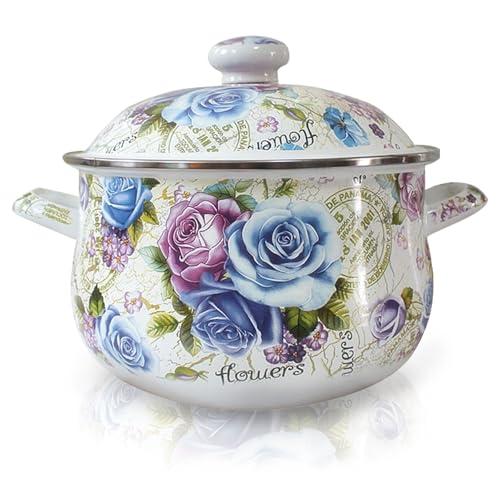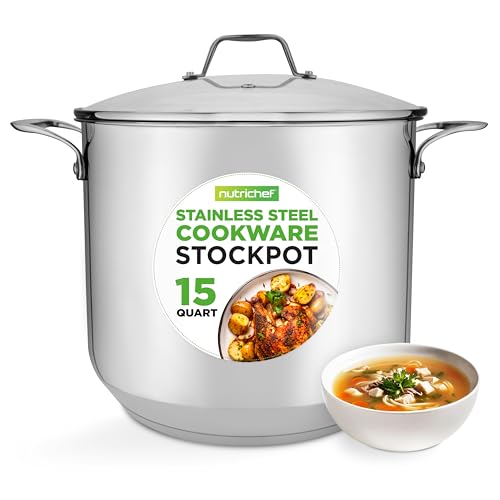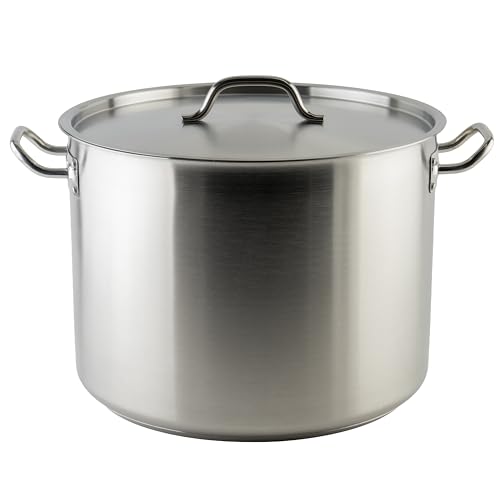There’s a specific kind of kitchen panic that sets in when you realize your ambition has outgrown your equipment. For me, it was the annual chili cook-off. My recipe, a slow-simmered behemoth of brisket, beans, and secret spices, was a crowd-pleaser, but my process was a nightmare. I was juggling three different pots on the stove, trying to sync simmering times and prevent scorching in thinner-bottomed pans. It was a chaotic, messy dance that left my stovetop a disaster zone and my final product inconsistent. The dream was one single, massive, reliable vessel that could handle the entire batch with grace and even heat. This wasn’t just about convenience; it was about elevating the craft and taking the stress out of cooking for a crowd. The search for a stockpot that was big enough, built to last, and wouldn’t break the bank led me directly to this intriguing contender: the Falaja 20 Quart Stock Pot.
- HEAVY & STURDY & HEALTHY: The large stock pot is made of superior, non-toxic and food grade stainless steel and well designed for...
- COMMERCIAL GRADE: Under strict industrial design standards, the non-nickel stainless steel soup pot features latest unibody tri-ply...
What to Consider Before Buying a Stockpot
A stockpot is more than just an oversized piece of cookware; it’s a key solution for any serious home cook who loves to entertain, meal prep for the week, or dive into projects like canning, preserving, or homebrewing. Its primary benefit is volume. It allows you to create foundational stocks and broths from scratch, simmer sauces for hours to develop deep flavors, or boil enough pasta for a family reunion without a second thought. It empowers you to think bigger in the kitchen, turning ambitious culinary projects into manageable, enjoyable experiences. Without a proper stockpot, these large-scale tasks become logistical puzzles, often resulting in compromised flavor and unnecessary stress.
The ideal customer for this type of product is someone facing the exact problems I did: the batch-cooker, the holiday host, the avid gardener preserving their harvest, or the aspiring home chef who needs commercial-grade capacity without the commercial-grade price tag. It’s for the person whose 8-quart dutch oven is starting to feel claustrophobic. On the other hand, it might not be suitable for those with limited kitchen or storage space, as a 20-quart pot has a significant footprint. If you primarily cook for one or two people and rarely tackle large recipes, a smaller 6 or 8-quart stockpot or a versatile dutch oven would be a more practical and efficient choice.
Before investing, consider these crucial points in detail:
- Dimensions & Space: A 20-quart (5-gallon) pot is substantial. Before you click “buy,” measure your stovetop to ensure it can accommodate the 11.81-inch diameter without crowding out other burners. Also, consider storage. This pot stands over 14 inches tall, so you’ll need adequate cabinet or pantry space to house it when not in use.
- Capacity/Performance: Twenty quarts is a massive volume perfect for making stock from multiple chicken carcasses, simmering a whole brisket for chili, or boiling several pounds of potatoes. The key performance factor is how well it manages that volume. Look for a thick, multi-layered base (like a tri-ply bottom) to ensure the heat distributes evenly and prevents scorching at the bottom, a common problem in large, thin-walled pots.
- Materials & Durability: Stainless steel is the go-to material for its durability and non-reactive properties. However, not all stainless steel is equal. Higher-end pots use 18/8 or 18/10 (chromium/nickel content) steel for superior rust resistance. The Falaja uses non-nickel stainless steel, likely a 400-series, which makes it magnetic and thus induction-compatible, but can potentially be more susceptible to rust if not cared for properly. A heavy-gauge construction is non-negotiable for a pot this size to prevent warping under high heat.
- Ease of Use & Maintenance: A 20-quart pot filled with liquid can weigh over 40 pounds. Sturdy, securely riveted handles are a critical safety feature for moving it from the stove to the sink. A well-fitting lid, preferably with steam vents, helps control evaporation and prevent boil-overs. For maintenance, a brushed interior finish can help hide minor scratches, but be prepared for the reality that cleaning a pot this large by hand requires some elbow grease.
Understanding these factors is key to choosing the right tool for your culinary ambitions, ensuring your new stockpot is a trusted partner rather than a cumbersome burden.
While the Falaja 20 Quart Stock Pot is an excellent choice, it’s always wise to see how it stacks up against the competition. For a broader look at all the top models, we highly recommend checking out our complete, in-depth guide:
- Stainless steel and 5 layers bottom: Kirecoo 8-Quart Stainless Steel Stockpot with Lid is an essential kitchen cookware, boasting an...
- Large capacity: holds up to 8 quarts--great for large batches of soups, stews, and more
- Uniform heat dissipation:Perfect for Electric stove/Halogen stove/Induction cooktop/Gas stove. Warm Tip: The enamel products may...
First Impressions: Unboxing the Falaja Beast
The Falaja 20 Quart Stock Pot arrived securely packaged, and my immediate first impression upon lifting it from the box was one of pure heft. This is not a flimsy, department-store pot. It has a satisfying weight and rigidity that instantly communicates durability, confirming user reports that it feels “heavy and thick.” The main body features an elegant, brushed stainless steel finish that looks professional and feels resistant to fingerprints. This is beautifully contrasted by a polished reinforcement ring at the top and gleaming, solid-looking handles. It looks and feels like it belongs in a bustling restaurant kitchen, a sentiment echoed by users who call it a “beast” and “commercial quality.”
The construction feels solid through and through. The handles are attached with heavy-duty rivets, and there’s no flex or give when you handle the pot. The lid is a standout feature right out of the box; it’s designed to sit snugly in a recessed groove, creating a better seal than a simple overlay lid. The inclusion of three small steam vents is a thoughtful touch, promising an end to the annoying rattling and lid-lifting that happens during a long, vigorous simmer. Inside, the laser-etched measurement markings are clear and a genuinely useful feature for adding liquids without needing a separate measuring cup. Overall, the initial impression is that of a serious, well-built tool that offers incredible substance for its price point. You can immediately see its full feature set and user reviews to get a sense of its robust build.
What We Like
- Heavy-duty, commercial-grade stainless steel construction feels incredibly sturdy.
- Generous 20-quart capacity is perfect for large-batch cooking, canning, and entertaining.
- Thoughtful design features like the vented, sunken lid and internal volume markings.
- Tri-ply base provides surprisingly even heat distribution, minimizing hot spots.
Drawbacks
- Conflicting user reports on its compatibility with all induction cooktops.
- Non-nickel stainless steel may be more prone to staining or rust than premium alternatives.
A Deep Dive into the Falaja 20 Quart Stock Pot’s Performance
A stockpot’s true character is revealed not on the shelf, but on the stove, under heat, and full of ingredients. To put the Falaja through its paces, we decided to tackle two distinct challenges: a massive 16-quart batch of rich, slow-simmered beef bone broth requiring low, steady heat for over 12 hours, and a rapid, rolling boil for a family-sized portion of pasta. This allowed us to test its heat distribution, retention, and overall usability under different conditions.
Construction and Durability: A Commercial Kitchen Feel
The single most impressive aspect of the Falaja 20 Quart Stock Pot is its sheer physical presence. The manufacturer claims an “upgraded thickness,” and we can confirm this isn’t just marketing fluff. The walls are rigid and resist flexing, even when hot. The polished reinforcement ring around the top isn’t merely decorative; it adds significant structural integrity, preventing the pot from going out of round, which is a real risk with large, lesser-quality pots. The handles are a masterclass in functional design. They are thick, securely fastened with substantial rivets, and provide enough clearance from the pot’s body to get a confident grip, even with oven mitts on. When we had to move 4 gallons of simmering broth, we never once felt like the handles were a point of failure, a critical safety consideration.
The choice of “non-nickel, food-grade stainless steel” is a key point to understand. This typically refers to a 400-series stainless steel (like 18/0). The primary benefit is that it’s ferromagnetic, which is what makes it compatible with induction cooktops. The trade-off is that it generally has lower corrosion resistance compared to the 18/8 or 18/10 stainless steel found in more expensive cookware. This provides a scientific explanation for the user reports of rust spots or discoloration appearing after a few uses. During our testing, after a 12-hour simmer and a thorough hand-washing, we did notice some slight interior discoloration or “heat tint,” which is a common rainbow-like effect on stainless steel and is harmless. We did not experience rust, but we were careful to dry the pot immediately after washing. This suggests that while the pot is robustly built, it may require more diligent care—thorough drying and avoiding prolonged exposure to acidic foods—to maintain its pristine finish. This is a reasonable compromise for a pot with a feature set that punches well above its price tag.
Heating Performance and Versatility
The heart of any great pot is its base, and the Falaja’s unibody tri-ply construction on the bottom is where it truly shines. This layered design, typically an aluminum core sandwiched between stainless steel, is crucial for distributing heat evenly across the pot’s wide diameter. During our bone broth test on a gas range, this proved its worth. We were able to maintain a very low, consistent simmer without any “hot spots” causing the ingredients on the bottom to scorch. The heat was gentle and uniform, exactly what you need for extracting flavor over many hours. When we switched to the pasta test, the pot brought 4 gallons of water to a rolling boil efficiently, and the thick base helped it return to a boil quickly after adding the pasta.
Now, for the most contentious point: induction compatibility. The product is marketed as induction-ready, and the magnetic nature of its stainless steel construction supports this claim. We tested it on our portable induction burner, and it worked flawlessly, heating up quickly and responding to temperature changes. However, it’s impossible to ignore the user who stated unequivocally that it “will not work on an induction burner.” This discrepancy can often be attributed to the specific induction cooktop being used. Some burners have minimum diameter requirements or sensitivity sensors that can be finicky with certain pots. Our expert conclusion is that the pot *is* designed for induction, but there exists a small possibility of incompatibility with certain models. If induction is your only cooking method, this is a risk to be aware of, but for gas, electric, and ceramic users, its performance is excellent and reliable.
Design and Ergonomics: The Little Details That Matter
Beyond the raw materials and heating, Falaja has incorporated several design elements that significantly improve the user experience. The sunken lid design is genuinely brilliant. By sitting inside the rim, it creates a much better seal, trapping moisture and heat more effectively. The three steam vents worked perfectly, allowing just enough pressure to escape to prevent the lid from rattling or the contents from boiling over aggressively. This was a feature specifically praised by users, and our experience confirmed its value for long, unattended cooks.
The interior measurement markings, etched in both quarts and liters, are another fantastic touch. For a recipe like our broth, which required a specific starting volume of water, this allowed us to fill the pot directly on the stove without using other containers, saving time and cleanup. Cleaning the massive pot was, as expected, a bit of a workout. However, the brushed finish on both the interior and exterior was relatively forgiving. There are no tight corners or crevices where food can get trapped, and the rivets are smooth and low-profile on the inside, making it easy to scrub around them. While lifting a full pot is a two-person job for safety, the well-designed handles make it as secure as possible. These thoughtful details demonstrate a focus on practical, real-world use that makes the Falaja 20 Quart Stock Pot a joy to work with, despite its intimidating size.
What Other Users Are Saying
A survey of user feedback reveals a largely positive but polarized consensus that aligns closely with our own findings. The overwhelming majority of positive comments center on the pot’s impressive build quality and sheer value. Phrases like “beautiful and it is a beast,” “heavy duty stainless steel,” and “restaurant quality stock pot” appear frequently. Many, like us, were pleasantly surprised by the heft and sturdiness at this price point, calling it “over built for home kitchen use” in the best possible way.
However, the negative feedback highlights two critical, recurring concerns. The most serious is the report of rust developing after only a few uses. One user stated bluntly, “Rust and beans just don’t go well together,” forcing them to discard the pot. This supports our analysis of the non-nickel stainless steel potentially being less corrosion-resistant. The second major issue is the conflicting experience with induction cooktops. While the product is advertised as compatible, at least one user found it did not work at all, forcing them to give it away. These negative points, while not experienced by everyone, represent significant potential drawbacks that prospective buyers must weigh against the pot’s otherwise stellar construction and value.
How Does the Falaja 20 Quart Stock Pot Compare to the Alternatives?
The Falaja 20 Quart Stock Pot occupies a compelling space in the market, but it’s not without competition. Here’s how it stacks up against three notable alternatives, each catering to a slightly different user.
1. NutriChef 15-Quart Stainless Steel Stock Pot
- 15 QUARTS: The NutriChef Stainless Steel Large Cooking Pot features 15-quart capacity weighing 6.7 lbs w/ lid which is the perfect size...
- ERGONOMIC HANDLES: Features ergonomic stainless steel handles for comfortable handling & cooking. Offers a stylish & modern design w/...
The NutriChef offers a slightly smaller 15-quart capacity, making it a great choice for cooks who need a large pot but find the 20-quart Falaja to be a bit excessive for their needs or storage space. Its most significant distinguishing feature is the tempered glass lid, which allows you to monitor your cooking progress without releasing heat and moisture. While the Falaja’s solid steel lid offers better heat retention for long simmers, the NutriChef’s glass lid provides convenience for dishes that require more active observation. If you value visual monitoring over maximum thermal efficiency and a 15-quart size is sufficient, the NutriChef is a very strong contender.
2. Winco SST-40 40 Quart Stock Pot
- Superior Heating – Tri-ply construction provides the even-heating for a premium cooking experience ideal for soups, sauces, and more
- Commercial-Grade – Made from heavy-duty 18/8 stainless steel for maximum durability ideal for use in restaurant and institutional...
If the Falaja is a beast, the Winco SST-40 is a monster. With a colossal 40-quart (10-gallon) capacity, this pot is aimed at homebrewers, caterers, or those cooking for very large crowds where even 20 quarts won’t suffice. The Winco is a no-frills, commercial workhorse, prioritizing sheer volume and durability over aesthetic finesse. It lacks some of the Falaja’s user-friendly features like the detailed internal markings or the sunken lid design. This is the pot you choose when capacity is your absolute, number-one priority and you need a tool built for production-level cooking.
3. Farberware Classic Stainless Steel 6-Quart Stockpot
- EASY TO CLEAN: This stainless steel dishwasher safe stockpot combines technology with the styling and quality that Farberware has...
- CLASSIC STAINLESS STEEL: The generous, classic 6 quart stock pot's heavy-duty stainless steel is polished to a mirror finish for a...
The Farberware Classic represents the other end of the spectrum. At 6 quarts, it’s an everyday stockpot perfect for making pasta for the family, a weeknight soup, or a small batch of chili. It highlights just how specialized the Falaja is. The Farberware is nimble, easy to clean, and fits on any stove and in any cabinet. It’s the perfect choice for a home cook who doesn’t need to feed an army. If your cooking ambitions are more modest, the Farberware is a more practical, manageable, and classic choice for daily tasks.
The Final Verdict: A High-Capacity Powerhouse with a Caveat
After extensive testing and analysis, our verdict on the Falaja 20 Quart Stock Pot is overwhelmingly positive, with a couple of important qualifications. This pot delivers phenomenal value, offering a commercial-grade build, massive capacity, and thoughtful design features that are typically found on much more expensive cookware. Its heavy-duty construction and excellent heat distribution from the tri-ply base make it a reliable partner for any large-scale cooking project, from simmering stocks to boiling crawfish. For cooks using gas or electric stovetops who have been dreaming of a single, massive pot to unleash their culinary ambitions, this is an absolute workhorse that is hard to beat.
However, the potential issues with rust and the conflicting reports on induction compatibility cannot be ignored. The use of non-nickel stainless steel means it requires more diligent care—specifically, immediate and thorough drying—to keep it in top condition. If you are an induction cooktop owner or are unwilling to be meticulous with cleaning, you may want to consider other options. For everyone else, the Falaja represents a rare opportunity to bring restaurant-level capacity and build quality into the home kitchen at an accessible price. If you’re ready to stop juggling small pans and start cooking for a crowd with confidence, we highly recommend you check the latest price and availability on this impressive stockpot.
Last update on 2025-11-16 / Affiliate links / Images from Amazon Product Advertising API







